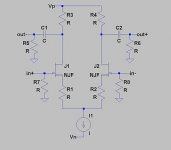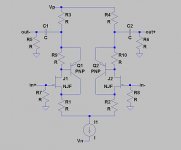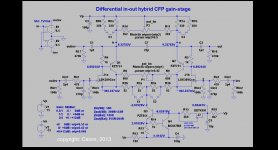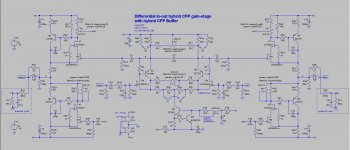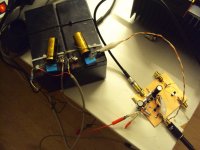Hi,
Alfred and Joachim. Where are You at the show? I liked to drop by and say hello, or you can visit me at booth C06 in Hall3 and see the future *lool*
jauu
Calvin
What is your "future"? I assume it's out in public at the show and you can talk about it.
Hi,
CD is dying! It's reinage comes to an end. Streaming solutions are taking over.
But while streaming clients are poppping up at every corner, there are only a few server systems which can do away with the inherent problems and deficiencies of Client-Systems. And I'm quite proud to say that we can offer one of the most refined if not The most refined Music servers at the time under our label purist and as OEM-solutions.
jauu
Calvin
ps. and now back to topic
CD is dying! It's reinage comes to an end. Streaming solutions are taking over.
But while streaming clients are poppping up at every corner, there are only a few server systems which can do away with the inherent problems and deficiencies of Client-Systems. And I'm quite proud to say that we can offer one of the most refined if not The most refined Music servers at the time under our label purist and as OEM-solutions.
jauu
Calvin
ps. and now back to topic
As someone how works in the IT industry I´m always astonished how such "solutions" which "do away" with (unidentified) "inherent problems" are sold to customers while providing services which can be implemented with commodity hardware and some open source software at a fraction of the price.
But nevertheless, good luck with your business.
But nevertheless, good luck with your business.
Hi,
as someone who motor bikes I'm always astonished how such "solutions", as for example special tires, are sold to customers while providing services which can be implemented with any wheel as long as its round and cheap.
As ITist You will know that a good software is not the software that offers functionality, but one that the user can work with best.
Most customers in HiFi are no ITist, nor do they want to deal with "computer issues" whatsoever in their free time. They don't want computer stuff in their living room and most certainly no piles of technical devices crammed side to side to their TV screen and flower pots. So the user interface needs to be as intuitive and simple as possible, as must be the setup and handling of the devices. This is certainly not the case with open source software and a pile of hadware.
Or as VW says in an actual advertising of the Golf GTI:
"often copied, never equaled"
jauu
Calvin
ps. thanks alot for the good wishes ;-)
as someone who motor bikes I'm always astonished how such "solutions", as for example special tires, are sold to customers while providing services which can be implemented with any wheel as long as its round and cheap.
As ITist You will know that a good software is not the software that offers functionality, but one that the user can work with best.
Most customers in HiFi are no ITist, nor do they want to deal with "computer issues" whatsoever in their free time. They don't want computer stuff in their living room and most certainly no piles of technical devices crammed side to side to their TV screen and flower pots. So the user interface needs to be as intuitive and simple as possible, as must be the setup and handling of the devices. This is certainly not the case with open source software and a pile of hadware.
Or as VW says in an actual advertising of the Golf GTI:
"often copied, never equaled"
jauu
Calvin
ps. thanks alot for the good wishes ;-)
....... most certainly no piles of technical devices crammed side to side to their TV screen and flower pots....
well, thats not true for me (to the despair of my wife
but your point is absolutely valid, I think. I just put a mountain of CDs aside that I am no longer listening to. A whole bunch is on the server, as MP3s..... Need to find a good solution for high-res.....
Hi,
as the question arose in the Paradise thread about the possibility of creating a SE-to-Bal Converter using the Calvin Buffer, I suggested to possible solutions under useage of two Calvin-Buffers. First is to put a simple inverter stage ahead of one of the buffers and the second was to put a fully differential stage ahead of the buffers.
Since a fully differential stage offers more flexibility I´d like to concentrate on that one.
jauu
Calvin
as the question arose in the Paradise thread about the possibility of creating a SE-to-Bal Converter using the Calvin Buffer, I suggested to possible solutions under useage of two Calvin-Buffers. First is to put a simple inverter stage ahead of one of the buffers and the second was to put a fully differential stage ahead of the buffers.
Since a fully differential stage offers more flexibility I´d like to concentrate on that one.
jauu
Calvin
Hi,
in a simple form the fully differential stage may look like the left circuit.
The relationship between drain and source resistors defines the gain.
THD of such a stage is rather high at >0.1% (-60dB and higher) but with a nicely falling harmonic distribution.
Cascoding the JFET doesn´t improve THD significantely but reduces maximum output voltage which is already low with supply voltages of +-15V.
Things change to the better if we use a CFP like the circuit to the right instead of the single input transistors, for example a JFET-Master controlling a bipolar PNP-Slave, similar to the Calvin-Buffer. This reduces THD by up to 30-40dB against the simple stage, thereby preserving the good THD-Values of the Buffers. The improvement is due to a vastly reduced signal current amplitude through the JFET, since the bipolar slave takes over most of the current swing. At the same the connection of the JFET´s source with the bipolar´s collector closes a very short current feedback loop.
jauu
Calvin
in a simple form the fully differential stage may look like the left circuit.
The relationship between drain and source resistors defines the gain.
THD of such a stage is rather high at >0.1% (-60dB and higher) but with a nicely falling harmonic distribution.
Cascoding the JFET doesn´t improve THD significantely but reduces maximum output voltage which is already low with supply voltages of +-15V.
Things change to the better if we use a CFP like the circuit to the right instead of the single input transistors, for example a JFET-Master controlling a bipolar PNP-Slave, similar to the Calvin-Buffer. This reduces THD by up to 30-40dB against the simple stage, thereby preserving the good THD-Values of the Buffers. The improvement is due to a vastly reduced signal current amplitude through the JFET, since the bipolar slave takes over most of the current swing. At the same the connection of the JFET´s source with the bipolar´s collector closes a very short current feedback loop.
jauu
Calvin
Attachments
Hi,
here´s an dimensioned example of the fully differential hybrid CFP gain stage in all-SMD style. It appears more complicated but You´ll recognize the basic CFP-structure.
As input JFETs serves the LKS389C in SOIC8 casing again. As bipolar slave we find the Zetex FZT751 in SOT223 (both casings are quite easy to hand solder).
The tail current source is made up from the two transistors Q3/Q4/R13/R4.
Q3 a Zetey FZT651 in SOT223, Q4 a BC847 in SOT23.
R12/C4 form a power supply filter feeding into the tail-CCS. It also drops a couple of volts to reduce power heat dissipation.
The input of the tail-CCS is supplied via a JFET-CCS J2/R15 that itself is supplied over a RC power supply filter R16/C5 from the positive spower supply.
Instead of the JFET-CCS a simple resistor R15 of 10K would also suffice.
The audio signal is fed via two RC-Bandpasses into the JFET-Gates.
The audio signal may be fed balanced into both inputs or SE into the noninv-input with the inv-input grounded.
C1 and C2 dc-block against the outputs and R17 and R18 are preloading resistors and bleeders for C1/C2.
The gain of the stage is set by the relationship of the Drain- to the Source-resistors. To allow for gain-setting and trimming the drain and source circuits are a bit more complex.
X1....X4 are Jumpers for various resistor combinations allowing for different gain-settings.
R6a/6b and R7a/7b are the Drain resistors.
R10/11/P2 are paralleled to the Drain-resistors R6/R7 to allow to trim both outputs to equal amplitude.
R2a/r2b and R3a/R3b are the source resistors.
R8/R9/P1 form a similar arrangement as in the Drain-circuit but this time allowing to trim the gain. If not wished for omit with them.
C7 is a small compensation cap, reducing gain at HF, preventing possible oscillation.
As said, the relationship of Drain to the Source resistors defines the gain.
But what is the gain here?
Since we can feed the signal either balanced or singleended and can take the output signal either balanced or singleended we have two pairs of two gain values:
1) Bal In --> SE Out
2) Bal In --> Bal Out
3) SE In --> SE Out
4) SE In --> Bal Out
In any case will the Bal Out be twice the voltage (+6dB) than the SE Out.
Depending on the Jumper setting this gives for a Input of 1.0Vrms, 0dB:
X1/2 open, X3/4 closed, wiper P1=0.55:
1) and 3): 500mVrms, -6dB
2) and 4): 1Vrms, 0dB
X1/2 open, X3/4 open, wiper P1=0.42:
1) and 3): 1Vrms, 0dB
2) and 4): 2Vrms, +6dB
and finally
X1/2 closed, X3/4 open, wiper P1=0.88:
1) and 3): 2Vrms, +6dB
2) and 4): 4Vrms, +12dB
The Poti P1 allows to trim the gain within a couple of mV to the desired value.
Simu results will follow.
jauu
Calvin
here´s an dimensioned example of the fully differential hybrid CFP gain stage in all-SMD style. It appears more complicated but You´ll recognize the basic CFP-structure.
As input JFETs serves the LKS389C in SOIC8 casing again. As bipolar slave we find the Zetex FZT751 in SOT223 (both casings are quite easy to hand solder).
The tail current source is made up from the two transistors Q3/Q4/R13/R4.
Q3 a Zetey FZT651 in SOT223, Q4 a BC847 in SOT23.
R12/C4 form a power supply filter feeding into the tail-CCS. It also drops a couple of volts to reduce power heat dissipation.
The input of the tail-CCS is supplied via a JFET-CCS J2/R15 that itself is supplied over a RC power supply filter R16/C5 from the positive spower supply.
Instead of the JFET-CCS a simple resistor R15 of 10K would also suffice.
The audio signal is fed via two RC-Bandpasses into the JFET-Gates.
The audio signal may be fed balanced into both inputs or SE into the noninv-input with the inv-input grounded.
C1 and C2 dc-block against the outputs and R17 and R18 are preloading resistors and bleeders for C1/C2.
The gain of the stage is set by the relationship of the Drain- to the Source-resistors. To allow for gain-setting and trimming the drain and source circuits are a bit more complex.
X1....X4 are Jumpers for various resistor combinations allowing for different gain-settings.
R6a/6b and R7a/7b are the Drain resistors.
R10/11/P2 are paralleled to the Drain-resistors R6/R7 to allow to trim both outputs to equal amplitude.
R2a/r2b and R3a/R3b are the source resistors.
R8/R9/P1 form a similar arrangement as in the Drain-circuit but this time allowing to trim the gain. If not wished for omit with them.
C7 is a small compensation cap, reducing gain at HF, preventing possible oscillation.
As said, the relationship of Drain to the Source resistors defines the gain.
But what is the gain here?
Since we can feed the signal either balanced or singleended and can take the output signal either balanced or singleended we have two pairs of two gain values:
1) Bal In --> SE Out
2) Bal In --> Bal Out
3) SE In --> SE Out
4) SE In --> Bal Out
In any case will the Bal Out be twice the voltage (+6dB) than the SE Out.
Depending on the Jumper setting this gives for a Input of 1.0Vrms, 0dB:
X1/2 open, X3/4 closed, wiper P1=0.55:
1) and 3): 500mVrms, -6dB
2) and 4): 1Vrms, 0dB
X1/2 open, X3/4 open, wiper P1=0.42:
1) and 3): 1Vrms, 0dB
2) and 4): 2Vrms, +6dB
and finally
X1/2 closed, X3/4 open, wiper P1=0.88:
1) and 3): 2Vrms, +6dB
2) and 4): 4Vrms, +12dB
The Poti P1 allows to trim the gain within a couple of mV to the desired value.
Simu results will follow.
jauu
Calvin
Attachments
Hi,
FFT of 1Vrms Vin Bal @1kHZ and X1...X4 open:
Vout(SE) =1Vrms, THD(1-4): 0.000709%, -103,0dB
Vout(Bal) =2Vrms, THD(1-4): 0.000681%, -103,3dB
FFT of 1Vrms Vin Bal @10kHz and X1...X4 open:
Vout(SE) =1Vrms, THD(1-4): 0.001093%, -99,2dB
Vout(Bal) =2Vrms, THD(1-4): 0.000750%, -102,5dB
Bandwidth limits (F-3dB): 0.8Hz - 1MHz
jauu
Calvin
FFT of 1Vrms Vin Bal @1kHZ and X1...X4 open:
Vout(SE) =1Vrms, THD(1-4): 0.000709%, -103,0dB
Vout(Bal) =2Vrms, THD(1-4): 0.000681%, -103,3dB
FFT of 1Vrms Vin Bal @10kHz and X1...X4 open:
Vout(SE) =1Vrms, THD(1-4): 0.001093%, -99,2dB
Vout(Bal) =2Vrms, THD(1-4): 0.000750%, -102,5dB
Bandwidth limits (F-3dB): 0.8Hz - 1MHz
jauu
Calvin
Hi,
next step is the inclusion of the Calvin Buffers to the gain-stage of #152.
THD(1kHz) @1Vrms in Bal,
Vout(SE): 1Vrms: 0.000764% -102.3dB
Vout(Bal): 2Vrms: 0.000684% -103.3dB
Output noise 20Hz-20kHz: 1.5µVrms -116.5dB
In the shown dimension output voltage may be up to 3Vrms SE and 6Vrms Bal.
This translates to input sensitivities of 1.5Vrms, 3Vrms and 4Vrms for high, middle and low gain setting. This is not much, but sufficient to drive any power amp from basically any source.
jauu
Calvin
next step is the inclusion of the Calvin Buffers to the gain-stage of #152.
THD(1kHz) @1Vrms in Bal,
Vout(SE): 1Vrms: 0.000764% -102.3dB
Vout(Bal): 2Vrms: 0.000684% -103.3dB
Output noise 20Hz-20kHz: 1.5µVrms -116.5dB
In the shown dimension output voltage may be up to 3Vrms SE and 6Vrms Bal.
This translates to input sensitivities of 1.5Vrms, 3Vrms and 4Vrms for high, middle and low gain setting. This is not much, but sufficient to drive any power amp from basically any source.
jauu
Calvin
Attachments
Yes, pretty cool. Now we have a discrete preamp.
Just for fun i build the Piglets Dad Bootstrapped Diamond Buffer.
I do not post a schematic here, you can see it on the Pink Fish Media forum.
Dadod has shown something like that here and the Paradise 1 also had a diamond bootstrap buffer based on my idea and optimized by MiiB, although with a different principle.
Next post will show the performance.
Just for fun i build the Piglets Dad Bootstrapped Diamond Buffer.
I do not post a schematic here, you can see it on the Pink Fish Media forum.
Dadod has shown something like that here and the Paradise 1 also had a diamond bootstrap buffer based on my idea and optimized by MiiB, although with a different principle.
Next post will show the performance.
Attachments
- Home
- Source & Line
- Analog Line Level
- Preamp-Buffers - simple idea
